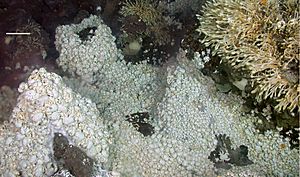Vulcanolepas osheai facts for kids
Quick facts for kids Vulcanolepas osheai |
|
|---|---|
| Scientific classification | |
| Kingdom: | |
| Phylum: | |
| Subphylum: | |
| Class: | |
| Order: | |
| Family: |
Eolepadidae
|
| Genus: |
Vulcanolepas
|
| Species: |
V. osheai
|
| Binomial name | |
| Vulcanolepas osheai (Buckeridge, 2000)
|
|
| Synonyms | |
|
Neolepas osheai Volcanolepas osheai |
|
Vulcanolepas osheai, also known as O'Shea's vent barnacle, is a special type of stalked barnacle. It belongs to the family Eolepadidae. This amazing creature is found only in New Zealand.
Where Does It Live?

This barnacle lives deep in the ocean, far below the surface. You can find it in a place called the Brother's Caldera, which is part of the Havre Trough. This area is about 700 kilometers off the coast of the Bay of Plenty near the North Island of New Zealand.
O'Shea's vent barnacles live very deep, from about 1,290 to 1,500 meters down. They like to be near hydrothermal vents and active underwater volcanoes. These vents release hot, mineral-rich water from the Earth's crust.
What Does It Look Like?
Vulcanolepas osheai has two main parts: a long stalk called a peduncle and a shell-like body called a capitulum. The stalk is usually about five times longer than the shell.
The shell is made of about eight strong, hard plates. A thin skin-like layer covers the shell. Because these barnacles live so close to hydrothermal vents, their shells often look black. This is from tiny bits of manganese minerals that settle on them.
The stalk is covered in many rows of small scales, each less than 1 millimeter in size. These scales are usually twice as long as they are wide. In bigger barnacles, you can see more than 100 rows of these tiny scales!
Tiny hairs on the barnacle's feeding parts often have special bacteria living on them. These bacteria are called epibionts because they live on the outside of the barnacle. Scientists think these barnacles eat bacteria that get energy from sulfur, or other tiny creatures that eat those bacteria. This food source is common around the hot vents.
How Did It Get Its Name?
The Vulcanolepas osheai barnacle is named after a person! It was named after Dr. Steve O'Shea. He used to be a curator (someone who manages collections) at the National Institute of Water and Atmospheric Research in Wellington, New Zealand.

